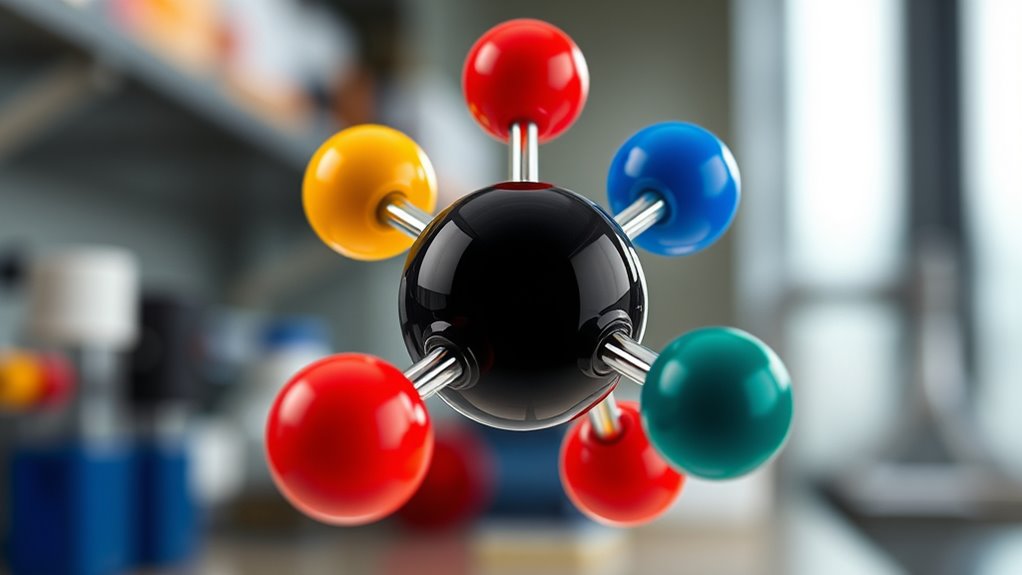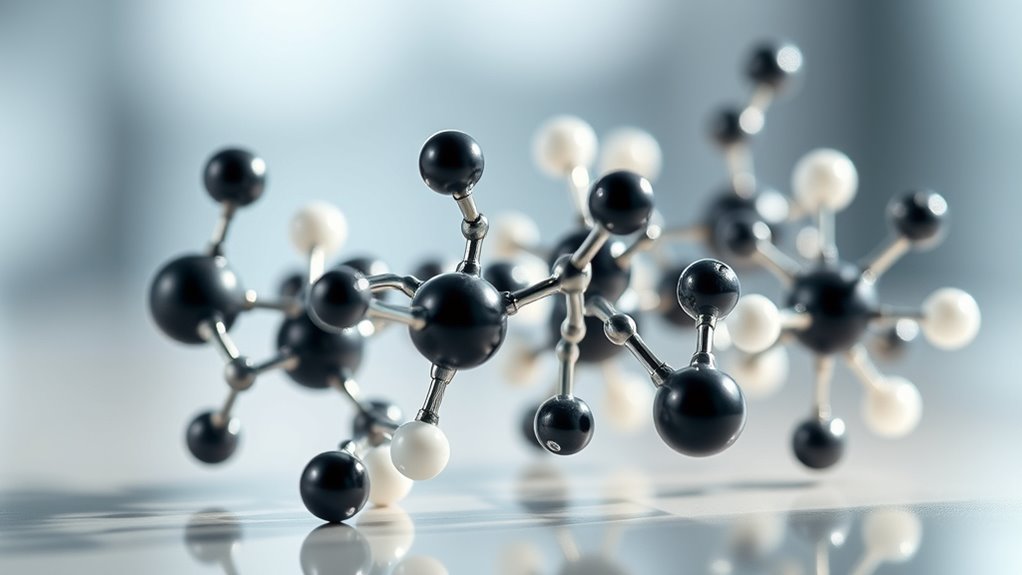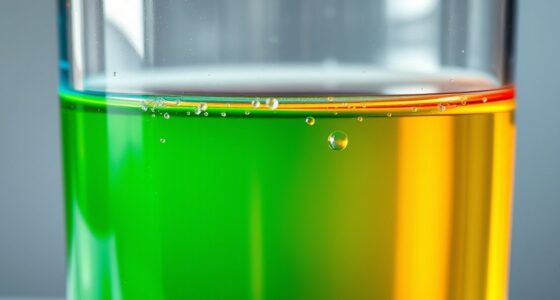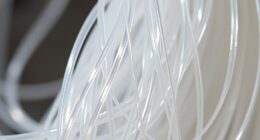Carbon’s ability to hybridize its orbitals allows it to form a wide variety of stable, complex compounds. By switching between sp³, sp², and sp hybridizations, it creates different shapes and bond angles, such as tetrahedral, trigonal planar, and linear. This versatility enables carbon to bond in many ways, building diverse molecules essential in nature and industry. Keep exploring to see how this is the foundation of countless important compounds.
Key Takeaways
- Carbon’s ability to hybridize into sp, sp², and sp³ orbitals creates diverse molecular geometries.
- Hybridization determines bond angles and shapes, enabling carbon to form stable, varied compounds.
- The flexibility of carbon’s hybrid orbitals allows for multiple bonding configurations, including single, double, and triple bonds.
- Carbon’s hybridization states facilitate the formation of complex, stable molecules in organic chemistry.
- This versatility underpins carbon’s central role in creating a vast array of biological and industrial compounds.

Have you ever wondered how atoms bond to form complex molecules? The answer lies in understanding the way atoms arrange themselves and how their bonds influence molecular shapes. When two or more atoms come together, they do so by sharing electrons, creating chemical bonds. The shape of the resulting molecule isn’t random; it’s dictated by the concept of molecular geometry, which determines the spatial arrangement of atoms.
This geometry is essential because it influences a molecule’s physical and chemical properties. Molecular geometry affects how molecules interact, react, and function in different environments. The electron pair repulsion theory explains how lone pairs and bonding pairs compete to position themselves in three-dimensional space, further influencing molecular shape.
In particular, bond angles play a critical role in defining molecular geometry. Bond angles are the angles between bonds that connect atoms in a molecule. These angles aren’t arbitrary—they’re influenced by the types of hybrid orbitals involved and the repulsion between electron pairs.
For example, in molecules where carbon forms four single bonds, such as methane (CH₄), the bonds arrange themselves to minimize repulsion, leading to a tetrahedral shape with bond angles close to 109.5 degrees. This specific bond angle helps maintain the molecule’s stability and impacts how it interacts with other molecules.
Carbon’s ability to hybridize its orbitals is the key reason it can form so many different compounds. Hybridization involves mixing atomic orbitals to create new hybrid orbitals that are energetically favorable for bonding.
In the case of carbon, the most common hybridizations are sp³, sp², and sp. Each hybridization state results in a different molecular geometry and bond angles.
For instance, sp³ hybridization produces tetrahedral geometries with bond angles around 109.5 degrees, as seen in alkanes.
Sp² hybridization results in trigonal planar shapes with bond angles near 120 degrees, typical of alkenes.
Sp hybridization leads to linear structures with bond angles of 180 degrees, found in alkynes.
This flexibility in hybridization and geometry allows carbon to create a vast array of compounds, from simple hydrocarbons to complex biomolecules. The hybrid orbitals enable diverse bonding patterns that are fundamental to organic chemistry.
The ability to control bond angles and molecular shape through hybridization means that carbon can form stable, diverse structures with different physical and chemical characteristics.
It’s this versatility that makes carbon the foundation of organic chemistry and the reason why so many essential compounds in nature and industry are based on carbon skeletons.
Frequently Asked Questions
How Does Hybridization Influence the Physical Properties of Compounds?
Hybridization influences the physical properties of compounds by shaping their molecular geometry, which affects how molecules pack and interact.
When you understand hybridization, you see how it alters bond angles and bond strength, impacting melting and boiling points.
For example, sp3 hybridization creates tetrahedral geometry, leading to different physical characteristics compared to sp hybridization.
This knowledge helps you predict how compounds behave based on their hybridization and resulting molecular structure.
Are There Exceptions to Typical Hybridization Patterns in Organic Molecules?
You might wonder if there are exceptions to typical hybridization patterns in organic molecules. Yes, hybridization anomalies do occur, leading to atypical bonding situations.
For example, molecules with unusual bond angles or unexpected hybridization states challenge standard models. These exceptions happen due to factors like strain or electronic effects, showing that hybridization isn’t always straightforward.
Some molecules adopt unique bonding arrangements to stabilize themselves.
How Does Hybridization Affect Reactivity in Organic Chemistry?
They say, “The devil is in the details.” Hybridization influences reactivity by shaping orbital overlap and molecular geometry. When orbitals mix, it creates specific shapes that make molecules more or less reactive.
For example, sp2 hybridization leads to planar structures with accessible orbitals, increasing reactivity. Understanding these effects helps you predict how molecules will behave in chemical reactions and guides you in designing new compounds with desired properties.
Can Hybridization Be Manipulated Experimentally?
You can manipulate hybridization experimentally using hybridization techniques, allowing you to modify atomic orbitals in molecules. By applying methods like applying pressure, changing temperature, or introducing catalysts, you influence the electronic environment and induce experimental hybridization.
This process helps you control molecular geometry and reactivity, making it a valuable tool in organic synthesis and material design. Your understanding of experimental hybridization opens new pathways for customizing chemical properties.
What Role Does Hybridization Play in Biological Molecules?
You might wonder how hybridization influences biological molecules. It plays a vital role in shaping biological structure, as the hybrid orbitals determine the three-dimensional arrangement of atoms.
This affects how enzymes interact with substrates, directly impacting enzyme activity. By enabling specific bonding patterns, hybridization helps maintain proper molecular shapes essential for biological functions, ensuring structural stability and efficient biochemical reactions in living organisms.
Conclusion
Now you see why carbon’s versatility makes it the backbone of countless compounds. Like a chameleon, it effortlessly switches hybridizations, adapting to different bonds and shapes. Just as a painter uses a palette of colors to create endless masterpieces, carbon’s hybridization options let it craft everything from simple gases to complex life forms. So, next time you breathe or look around, remember: it’s all thanks to carbon’s incredible ability to hybridize and build our world.









